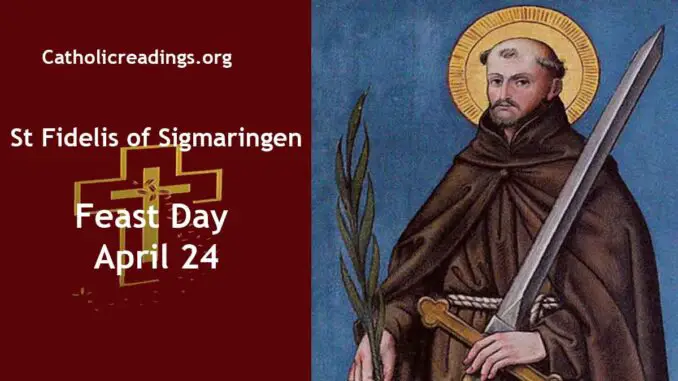St Fidelis of Sigmaringen, also known as Mark or Markus Roy, was a Capuchin friar who was involved in the Catholic Counter-Reformation in Switzerland.
He was born in Sigmaringen, Germany in 1577 and died as a martyr on April 24 1622 in Grüsch, Seewis im Prättigau, Switzerland.
We celebrate his feast day on April 24 every year in the Catholic Church.
| St Fidelis of Sigmaringen Biography | |
|---|---|
 |
|
| Date of Birth | 1577 AD |
| Place of Birth | Sigmaringen, Germany |
| Profession | Capuchin friar |
| Place of Work | Germany and Switzerland |
| Date of Death | April 24 1622 |
| Place of Death | Grüsch, Seewis im Prättigau, Switzerland |
| Feast Day | April 24 |
| Beatification | By Pope Benedict XIII on March 24 1729 |
| Canonization | By Pope Benedict XIV on June 29, 1746 in Rome |
| Patron Saint of | |
St Fidelis of Sigmaringen Life History
Mark Roy was born in 1577 in Sigmaringen, which is now part of Germany. His father, Johannes Roy, was an innkeeper and later became the mayor of the town.
St Fidelis frequently approached the sacraments, visited the sick and the poor, and spent moreover many hours before the altar.
After finishing his schooling, Mark studied philosophy and law in Freiburg im Breisgau. He then went on a tour with a nobleman and eventually earned his doctorate in law.
He became a lawyer and assessor at the Supreme Court in Ensisheim, where he advocated for the underprivileged and was referred to as the “Advocate for the Poor”.
Despite his efforts, it appears that his job did not bring him long-term happiness. He became disheartened by the mismanagement and corruption he observed, prompting him to join the Capuchin order, which his brother George was already a part of.
In 1612, he was ordained as a priest, and he spent the next few years working in various locations including Biberach, Altdorf, Bludenz, Kientzheim, and Rheinfelden.
Eventually, he became a preacher and superior at a monastery in Feldkirch. As a member of the Capuchin order, Markus Roy adopted the name Fidelis (“The Faithful”), which reflected his dedication to his work.
Fidelis supported the aims of the Catholic Counter-Reformation by establishing monasteries, providing pastoral care, delivering sermons, and creating educational institutions.
This period was marked by political instability, warfare, and food shortages caused by poor harvests. Concurrently, Europe was hit by the final devastating waves of the plague.
The Habsburgs’ effort to reestablish Catholicism in certain areas of the Prättigau was a component of their broader agenda.
This situation brought about a collision of geopolitical interests among the major European powers, complicated further by religious conflicts. In this chaotic scenario, Fidelis found himself embroiled in difficulties.
Fidelis arrived in Seewies on April 24, 1622, at a time when the entire region was experiencing intense tensions.
A rebellion against Habsburg rule had just been quashed, and practicing the Reformed faith had been outlawed.
In 1614 a Swiss Catholic bishop sought help from the Capuchins, to restore the faith and counteract the spread of Calvinist Protestantism.
The Capuchin order was tasked with overseeing pastoral care in the parish churches, and attendance at Catholic sermons was mandatory for all. The ultimate goal was to re-establish Catholicism throughout the country.
According to reports, on a particular Sunday in Seewies, after his sermon, he was waylaid by a body of Protestants headed by a minister, who attacked him and tried to force him to embrace their so-called reform.
The guard stationed outside the church was first overpowered, followed by the soldiers present inside.
Fidelis was then forcefully removed from the pulpit, taken to the cemetery in front of the church, and told that the attackers had long been eager to force him to confess but now he would have to confess to them.
They demanded unsuccessfully that he renounce the Catholic faith. But he said, “I came to refute your errors, not to embrace them; I will never renounce Catholic doctrine, which is the truth of all ages, and I fear not death.” After this, he was beaten to death with sticks and clubs.
Following his demise, Fidelis was initially interred at the church wall in Seewies. However, six months later, his remains were relocated to the Coire Cathedral, where they still rest today.
His head was taken to the Fidelis chapel at the Capuchin church in Weltkirchen, Feldkirch, Austria, where the Fidelis blessing is imparted on a weekly basis.
Shortly after his passing, calls for Fidelis’ canonization emerged, and he was eventually beatified in 1729 and canonized in 1746.
True to his name, Fidelis was an unwavering and committed advocate of Catholic doctrine. As the first Capuchin to lose his life while performing religious duties, he is commonly referred to as the “first martyr” of the Capuchin order.
Related Links
Powered By SEO Experts
Follow @ReadingCatholic